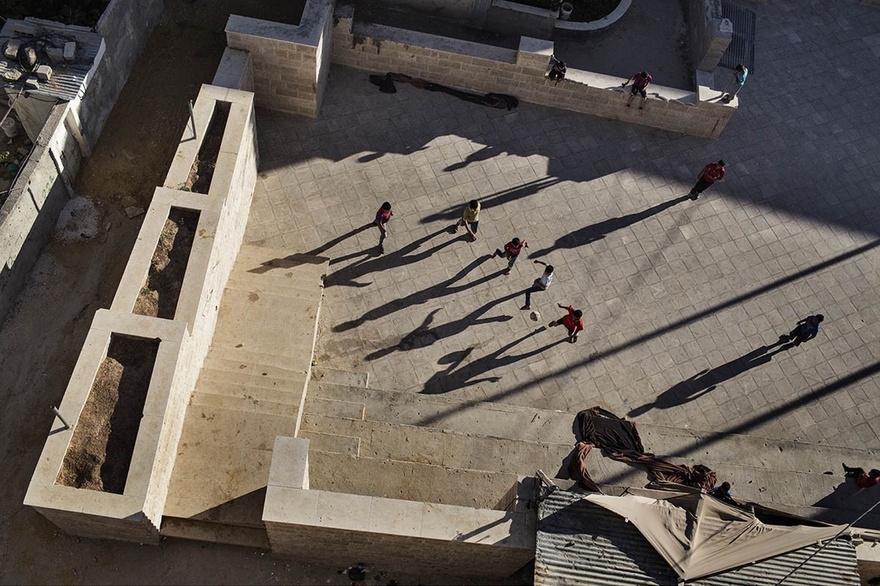In 2007, UNRWA´s Camp Improvement Programme began a participatory design process for the construction of a public square in Fawwar Refugee Camp. Questions emerged around the perceived consequences of building urban elements that resemble those of a city and therefore threaten the temporality of the camps jeopardizing the refugees' right of return. It reminded the community of the first years in the camp when, as winter arrived, they were forced to replace tents with shelters. After constructing the surrounding walls, they refused to construct roofs, as this would be a symbol of the end of the camp as a temporary space. After 60 years in exile, the community was faced with a new dilemma. What would the construction of a plaza signify in their struggle for a right of return? In parallel it raised another question: Who would use this plaza and especially what would be the role of women in this new public space? In a place where there is no public or private and no governing body, who would take care of this space? After long discussions, the community finally requested a closed plaza surrounded by walls. Unintentionally, the community's request resembled that roofless house built in the early years of the camp.
Since the construction of this space, the women in Fawwar have found, in the plaza, a space where not only can they interact but also learn from each other. In this very isolated environment, this space for learning has become a tool to connect with the world. However, this process has been gradual and at times challenging. The women of Fawwar are in the process of constructing a discourse that explains and justifies why they are claiming for a right to be in a public space.
This project seeks to create a narrative that further develops the relationship of women refugees in camps, with the built environment outside their home and how this relationship has been transformed not only through the camps history but also through their own lifetime, from girlhood to womanhood.
The outcome of the project will be a narrative story in English and Arabic, divided in three chapters and accompanied by illustrations that will depict the transformation of the house, the plaza and the women in the camp. The publication will target girls and young women in the camp and will be the main source of material for the exhibition that will take place in Qalandia International, a biennial event taking place in Palestinian cities, towns, and villages in October 2016.
The three chapters are:
1. Roofless House: Formation of the camp and the transition from tents to shelters
2. Roofless Plaza: The design process, the construction of the plaza and its spatial manifestation.
3. Roofless Revolution: The women's story and the formation of the women's right to public space group.
This research is part of the work carried out in Campus in Camps, engaging young participants in an experimental education program dealing with new forms of visual and cultural representations of refugee camps after almost sixty years of displacement. It was founded by Sandi Hilal and Alessandro Petti, which alongside research and practice through their architectural studio and art residency Decolonizing Architecture Art Residency (DAAR), began to engage in critical pedagogy through this experimental educational program in Dheisheh refugee camp Bethlehem, in partnership with Al Quds University and hosted by the Phoenix Centre. (www.campusincamps.ps).
In the last three years, academics and non-academics provided "courses" and public seminars, open to the local community and to students from other universities. Campus in Camps is hosted in Al Finiq cultural and community centre in Dheisheh and it offers spaces for classrooms, lecture hall, the Edward Said library, and the "Concrete Tent" for collective learning programs. The students are involved in nine ongoing initiatives that are implemented in six refugee camps. One of these initiatives is the work done by Ayat with the women in the public square in Fawwar.
Campus in Camps today is made up of two essential and interdependent pillars. The first one is the Consortium. Campus in Camps is collaborating with three local and three international Universities that are offering courses, seminars and workshops in Campus in Camps, involving students and teaching staff from the following Universities: Birzeit University, Birzeit, Palestine; International art Academy, Ramallah, Palestine; Dar El Kalima, Bethlehem, Palestine; Goldsmith University, London, United Kingdom; Mardin University, Mardin, Turkey; Leven University, Belgium. The second pillar is constituted by the self-organized courses offered by Campus in Camps members for the local community. These courses are changing every year, according to the participants' interests.
One of the courses that will be taught out in the next cycle will be on the women´s movement in Fawwar plaza. The course will be conducted by Sandi Hilal and will reflect on the questions stated above. Furthermore, the course will conclude with a publication that will compile the process as well as an exhibition that will be presented in Qalandia International, in October 2016.
About the artist

Sandi Hilal is an architect and researcher. She headed the United Nations Relief and Works Agency for Palestine Refugees in the Near East (UNRWA) Camp Improvement Program in the West Bank (2008-2014). She is a founding member and co-director of DAAR, an architectural office and an artistic residency program that combines conceptual speculations and architectural interventions. DAAR was awarded the Price Claus Prize for Architecture, the Foundation for Arts initiative Grant, shortlisted for the Iakov Chernikhov Prize and showed in various biennales and museums around the world (www.decolonizing.ps).
Alongside research and practice, Hilal is engaged in critical pedagogy. She is the founding member of Campus in Camps an experimental educational program in Dheisheh refugee camp Bethlehem (www.campusincamps.ps). She co-authored the book Architecture after Revolution (Sternberg, Berlin 2014), an invitation to rethink today's struggles for justice and equality, not only from the historical perspective of revolution, but also from that of a continued struggle for decolonization.
Hilal co-curated different research projects on the contemporary urban condition such as Border Devices (2002-2007) With Multiplicity (2001-2003) and Stateless Nation (with Alessandro Petti, 2002-2007). Her projects have been published in national and international newspapers and magazines, including the New York Times, Il Manifesto, Al Ayyam, Al- Quds, Art Forum and Archis. Hilal has been invited to lectures in several institutions and universities among others: Tate modern London, Columbia University, University of Exeter, American University of Beirut, University of London, Global Art Forum Dubai, Bard College University New York.

